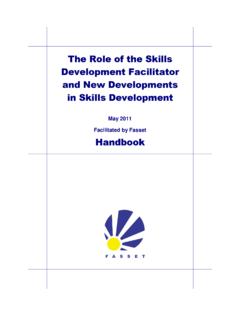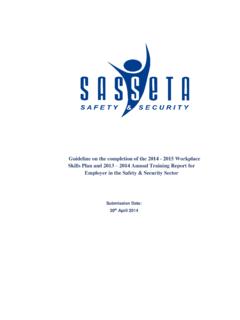Transcription of Facilitation Skills: Developing Facilitative Leadership
1 Facilitation skills : Developing Facilitative Leadership Groups that need to make decisions or engage in a planning process often find that using a trained facilitator makes this process more efficient and easier for everyone involved. A good facilitator can keep meetings focused on the subject of discussion or on dealing with the problem at hand; remind participants to consider the broader context of the issues; provide a neutral perspective and manage the process; move meetings along in a timely manner; help the group achieve useful meeting outcomes; and give the group a sense of accomplishment.
2 Responsibilities of a Facilitator Some of the key responsibilities of a facilitator include the following: Helping the group clarify its goals or desired outcomes. Helping group members use the same tool at the same time on the same problem to accomplish its goals or outcomes. Sometimes this involvement means helping the group change directions and redefine its goals and desired outcomes. The facilitator: Does not evaluate ideas Helps the group focus its energies on a task Suggests methods and procedures Protects all members of the group from attack Helps find win/win solutions Makes sure that everyone has the opportunity to participate.
3 Periodically summarizes the group consensus on issues to validate and clarify the progress of the discussion Adapted from Pickett Institute Curriculum, ILJ, 2002 1 How Facilitation Differs from Training and Presenting Training, public presentations, and facilitating share some common behavior and skills and often complement each other; but these are distinctly different developmental activities. Illustrated below are some characteristics of each. Training Presenting Facilitation Participants are present to learn.
4 Audience is present to receive prepared remarks. Participants are members of teams whose mission is to recommend new ideas or improvements. Objectives are based upon learning. Objectives are based on what is to be communicated, , sell, inform, motivate, describe. Objectives are based on process improvements. Lesson plans are prepared to enhance learning structure. Presenter s outline structures a logical presentation. An agenda is used to structure the meeting for effectiveness. Instructor is a catalyst for learning. Presenter primarily answers rather than asks questions.
5 Questions are used to develop individual involvement in the group. Instructor asks questions to evaluate learning. Visual aids are use to present data (charts, graphs, tables). Flip chart is used to record team member's inputs and ideas. Visual and training aids (tapes, films, cases, roleplays) are used to illustrate learning points. Data, charts, graphs are used to support messages or recommendations. Facilitator teaches members to use tools for team problem solving. Involvement (experiential learning) is used to learn from others' experience and retain interest.
6 Communication is largely one-way from presenter to audience. Facilitator manages the meeting structure, not content. Number of participants varies; usually under 50. Group can be any size. Team size is typically 5-15 members. Adapted from Pickett Institute Curriculum, ILJ, 2002 2 Suggestions for Facilitators The bullets below contain some suggestions and tips for facilitators to help prepare them for working with groups. Be aware of the physical environment and how it can influence group behavior. You may be able to arrange things to provide for greater participant comfort.
7 Think about such things as room setup, audiovisual needs, food or drink, distances between chairs, etc. If you are setting up the room, try arranging the chairs in a U-shaped semicircle, with the newsprint and the facilitator standing at the open end. Orient group to the timeframe and task at the beginning of each session. Make sure everyone understands the purpose of the meeting. Explain the product that is expected ( , small group key points; group decisions, etc.) Develop group ground rules, or norms for operating, and use them. Examples include: We re all colleagues let s respect each other; It s OK to disagree; Everyone participates, no one dominates; disregard rank/status.
8 If you don t have a co-facilitator, select someone to write key points on the flipchart. If group is large, use name tents to remember everyone s name. People like being called by their first name. Additional Considerations Be certain in advance that your sponsor (client, representative) agrees with the purpose and is comfortable with the process. Stay focused in the present but know where the group has been and where it needs to be. Choose a decisionmaking method BEFORE you need it. Suggest some options that the group could use to get them thinking.
9 Remember that people properly disagree. It's probably naive to think that there won't be moments of conflict in your group. Call a "pulse check" and check in with the group as to how people are feeling or what they are thinking about at that time. This is good to do when the group seems generally blocked or confused. If you have a lead Facilitation role, close each session with recognition of the group for a "job well done." Adapted from Pickett Institute Curriculum, ILJ, 2002 3 Role modeling of desirable behavior is important with the recorder, other staff, and the group.
10 Consider the potential impact of such things as a certain meeting location, a social versus a task-oriented agenda, the cultural diversity of attendees, and try to plan accordingly. Your own self-development can make a difference. Be aware of your own biases and acknowledge them. Ask yourself where you are in your own development of cultural consciousness. Effective Communication skills for Facilitators Communication skills are critical for a facilitator. How you communicate, aside from the substance of the event, can make a difference in gaining support and moving things along efficiently and effectively.












